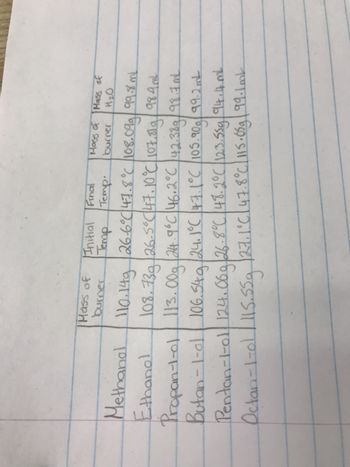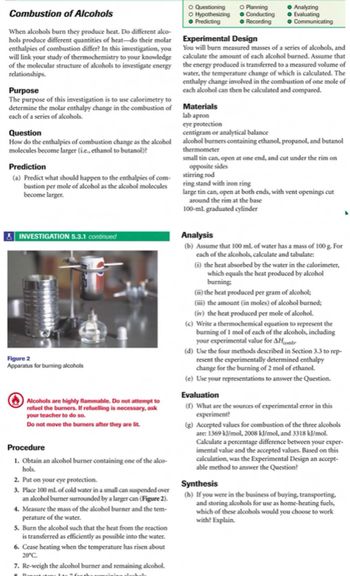
Chemistry
10th Edition
ISBN: 9781305957404
Author: Steven S. Zumdahl, Susan A. Zumdahl, Donald J. DeCoste
Publisher: Cengage Learning
expand_more
expand_more
format_list_bulleted
Concept explainers
Question
Please help me answer the questions from a to f using the data provided

Transcribed Image Text:Initial
Final
Temp Temp.
Mass of Mass of
burner H₂O
евь
Mass of
burner
Methanol 110.14g 26.6°C 47.8°C 108.09g| 99.8 ml
Ethanol
108.73g /26.5°C 47.10°C℃/107.51g|/ 98-9 m²
Propan-1-01 113.00g/24.9°C 46.2°C 42.38g 98.7.nd
Butan -1-01 106.54g/24.1°C 47.1°C 105.90g/99-2mL
Pentan-1-01 124.06g|26.8°C/48.2°C/123.55g|94.4 mL
Octan-1-01 | 115.55g |27.1°C / 47.8°C/115.05g|99-1ask

Transcribed Image Text:Combustion of Alcohols
When alcohols burn they produce heat. Do different alco-
hols produce different quantities of heat-do their molar
enthalpies of combustion differ? In this investigation, you
will link your study of thermochemistry to your knowledge
of the molecular structure of alcohols to investigate energy
relationships.
Purpose
The purpose of this investigation is to use calorimetry to
determine the molar enthalpy change in the combustion of
each of a series of alcohols.
Prediction
(a) Predict what should happen to the enthalpies of com-
bustion per mole of alcohol as the alcohol molecules
become larger.
INVESTIGATION 5.3.1 continued
Figure 2
Apparatus for burning alcohols
Alcohols are highly flammable. Do not attempt to
refuel the burners. If refuelling is necessary, ask
your teacher to do so.
Do not move the burners after they are lit.
Procedure
1. Obtain an alcohol burner containing one of the alco-
hols.
Question
centigram or analytical balance
How do the enthalpies of combustion change as the alcohol alcohol burners containing ethanol, propanol, and butanol
molecules become larger (i.e., ethanol to butanol)?
2. Put on your eye protection.
3. Place 100 ml. of cold water in a small can suspended over
an alcohol burner surrounded by a larger can (Figure 2).
4. Measure the mass of the alcohol burner and the tem-
perature of the water.
5. Burn the alcohol such that the heat from the reaction
is transferred as efficiently as possible into the water.
6. Cease heating when the temperature has risen about
20°C.
7. Re-weigh the alcohol burner and remaining alcohol.
O Questioning
O Hypothesizing
Predicting
mbal
O Planning
Materials
lab apron
eye protection
Conducting
Recording
● Analyzing
Evaluating
Communicating
Experimental Design
You will burn measured masses of a series of alcohols, and
calculate the amount of each alcohol burned. Assume that
the energy produced is transferred to a measured volume of
water, the temperature change of which is calculated. The
enthalpy change involved in the combustion of one mole of
each alcohol can then be calculated and compared.
thermometer
small tin can, open at one end, and cut under the rim on
opposite sides
stirring rod
ring stand with iron ring
large tin can, open at both ends, with vent openings cut
around the rim at the base
100-ml. graduated cylinder
Analysis
(b) Assume that 100 mL of water has a mass of 100 g. For
each of the alcohols, calculate and tabulate:
(i) the heat absorbed by the water in the calorimeter,
which equals the heat produced by alcohol
burning
(ii) the heat produced per gram of alcohol;
(iii) the amount (in moles) of alcohol burned;
(iv) the heat produced per mole of alcohol.
(c) Write a thermochemical equation to represent the
burning of 1 mol of each of the alcohols, including
your experimental value for AH comb
(d) Use the four methods described in Section 3.3 to rep-
resent the experimentally determined enthalpy
change for the burning of 2 mol of ethanol.
(e) Use your representations to answer the question.
Evaluation
(f) What are the sources of experimental error in this
experiment?
(g) Accepted values for combustion of the three alcohols
are: 1369 kJ/mol, 2008 kJ/mol, and 3318 kJ/mol.
Calculate a percentage difference between your exper-
imental value and the accepted values. Based on this
calculation, was the Experimental Design an accept-
able method to answer the Question?
Synthesis
(h) If you were in the business of buying, transporting.
and storing alcohols for use as home-heating fuels,
which of these alcohols would you choose to work
with? Explain.
Expert Solution
This question has been solved!
Explore an expertly crafted, step-by-step solution for a thorough understanding of key concepts.
Step by stepSolved in 4 steps

Knowledge Booster
Learn more about
Need a deep-dive on the concept behind this application? Look no further. Learn more about this topic, chemistry and related others by exploring similar questions and additional content below.Similar questions
- Q1: Write down the complete principle procedure apparatus of the saponification process?arrow_forwardThe solution calls for an exponent. How would I write that?arrow_forwardStep 2: Identify the dimensions of the quantities involved The second step is to identify the dimensions of the quantities involved in the problem. For example, if the problem involves distance, time, and velocity, the dimensions of these quantities would be length, time, and length/time, respectively. Step 3: Check if the units cancel out The third step is to check if the units cancel out. To do this, multiply the quantities together and check if the units cancel out, leaving only the desired unit. For example, if you are trying to find the velocity of an object and you know its distance and time, you can multiply distance by time to get velocity. If the units cancel out, you have a physically meaningful result. Step 4: Check if the result makes sense, to do this compare the units of the result with what you would expect based on the Robles statement. Using the step hints above, answer the question. You do not have to solve. Just imagine that you're teaching a friend how…arrow_forward
- Part carrow_forwardChemistry Compute 1240.64/12.5. Round the answer appropriately. Express your answer numerically using the proper number of significant figures.arrow_forwardI asked this before and the person said there was no data....i submitted the data in one picture and question in the second image! this is literally all of the information i have! that's why i am asking for help!!!arrow_forward
- In our first lab experiment we will be identifying metals by measuring theirdensities and comparing them to known values. Here at NJIT we have a very large and generouslaboratory materials budget, so all sorts of exotic and extremely valuable metals will be providedfor the experiment. Using the values listed below, determine the identity of the metal samples.If the density value determined is not amongst the values below then one of those cheapRutgers samples crept into our stock of metal samples and you should answer “unknown metal”.Note: volume measurements are not very exact. If your density determination is off by 0.1 or0.2 from the known value, that’s probably good enough for an identity. Table in image 4a. You weigh your sample and determine it weighs 71.8 grams. You put the sample into 15.6 mL ofwater and the total volume rises to 22.4 ml. What metal do you have?4b. You weigh your sample and determine it weighs 56.3 grams. You put the sample into 28.9 mL ofwater and the total…arrow_forward1 1/2 yr to months using dimensional analysisarrow_forwardExplain in reasoning how you would teach him to determine if his dimensional analysis is answers "make sense".arrow_forward
- es-2021S2 Allison.E CHEM X 2.ga.us/d21/Ims/quizzing/user/attempt/quiz_start_frame_auto.d2l?ou=2593077&isprv=&drc%3D1&qi=2478023&cfql=0&dnb%3D08fi lancer O Khan Academy E DeltaMath musictheory.net - E. Ca Desmos | Scientific. g Final Exam Ciara Smith: Attempt 1 D View hint for Question 18 Question 19 (3 points) Explain how OCompound A and Compound B will dissolve in water using the correct vocabulary including solvation, dissociatic n, ionic, and covalent. O Mg Cl CH Compound A Compound B hp 二arrow_forwardHow to calculate a retation time ? Can you give me an example with peaks pleasearrow_forwardWhy should repetitive measurements always be made, if possible, when performing an experiment. (Please give a detailed answer, thank you)arrow_forward
arrow_back_ios
SEE MORE QUESTIONS
arrow_forward_ios
Recommended textbooks for you
 ChemistryChemistryISBN:9781305957404Author:Steven S. Zumdahl, Susan A. Zumdahl, Donald J. DeCostePublisher:Cengage Learning
ChemistryChemistryISBN:9781305957404Author:Steven S. Zumdahl, Susan A. Zumdahl, Donald J. DeCostePublisher:Cengage Learning ChemistryChemistryISBN:9781259911156Author:Raymond Chang Dr., Jason Overby ProfessorPublisher:McGraw-Hill Education
ChemistryChemistryISBN:9781259911156Author:Raymond Chang Dr., Jason Overby ProfessorPublisher:McGraw-Hill Education Principles of Instrumental AnalysisChemistryISBN:9781305577213Author:Douglas A. Skoog, F. James Holler, Stanley R. CrouchPublisher:Cengage Learning
Principles of Instrumental AnalysisChemistryISBN:9781305577213Author:Douglas A. Skoog, F. James Holler, Stanley R. CrouchPublisher:Cengage Learning Organic ChemistryChemistryISBN:9780078021558Author:Janice Gorzynski Smith Dr.Publisher:McGraw-Hill Education
Organic ChemistryChemistryISBN:9780078021558Author:Janice Gorzynski Smith Dr.Publisher:McGraw-Hill Education Chemistry: Principles and ReactionsChemistryISBN:9781305079373Author:William L. Masterton, Cecile N. HurleyPublisher:Cengage Learning
Chemistry: Principles and ReactionsChemistryISBN:9781305079373Author:William L. Masterton, Cecile N. HurleyPublisher:Cengage Learning Elementary Principles of Chemical Processes, Bind...ChemistryISBN:9781118431221Author:Richard M. Felder, Ronald W. Rousseau, Lisa G. BullardPublisher:WILEY
Elementary Principles of Chemical Processes, Bind...ChemistryISBN:9781118431221Author:Richard M. Felder, Ronald W. Rousseau, Lisa G. BullardPublisher:WILEY

Chemistry
Chemistry
ISBN:9781305957404
Author:Steven S. Zumdahl, Susan A. Zumdahl, Donald J. DeCoste
Publisher:Cengage Learning

Chemistry
Chemistry
ISBN:9781259911156
Author:Raymond Chang Dr., Jason Overby Professor
Publisher:McGraw-Hill Education

Principles of Instrumental Analysis
Chemistry
ISBN:9781305577213
Author:Douglas A. Skoog, F. James Holler, Stanley R. Crouch
Publisher:Cengage Learning

Organic Chemistry
Chemistry
ISBN:9780078021558
Author:Janice Gorzynski Smith Dr.
Publisher:McGraw-Hill Education

Chemistry: Principles and Reactions
Chemistry
ISBN:9781305079373
Author:William L. Masterton, Cecile N. Hurley
Publisher:Cengage Learning

Elementary Principles of Chemical Processes, Bind...
Chemistry
ISBN:9781118431221
Author:Richard M. Felder, Ronald W. Rousseau, Lisa G. Bullard
Publisher:WILEY